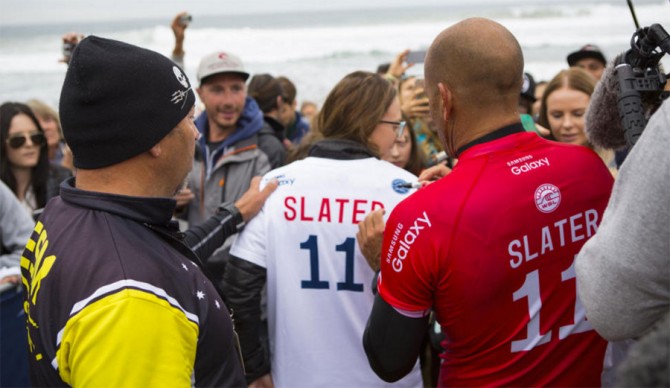
Slater jerseys are going like hotcakes. Photo: WSL
So the WSL just launched their latest money-spinning ploy. As of yesterday, there is a now a WSL store where you can buy all sorts of lovely fabrics bearing the WSL logo—t-shirts, sweatshirts, outerwear, and hats. Personally, I can’t see myself wearing a WSL branded jacket. The idea is a little ridiculous. I may be a fan of the sport, but that doesn’t mean I’m a fan of the bloody organization. I’ve definitely bought one or two things I’ve loved on Amazon, but that doesn’t mean I want to wear their logo on a hat. What next? Tea towels with Dave Prodan’s face? Richie Porta toilet paper? (Actually, that might work).
However, I am definitely a fan of the athletes themselves. And this new store offers “pro gear” in the form of athlete jerseys—these I do like. I might even be prepared to shell out the $80 USD as a mark of my fandom! The athlete jerseys should bring some much-needed cash for the organization, as well as helping to foster rivalries and build fanbases. The designs of the jerseys are centered around flags and nationalist identities, which, in turn, may stir the festering embers of discrimination between the (strikingly narrow) range of nationalities on tour. But that’s a different and potentially interesting story in itself.
I’ve always said that the WSL needs to capitalize on personalities, not stifle them. Let’s face it, we all have our little favorites, don’t we? Maybe you swoon at the handsome eyes of young Julian Wilson and would lust for the number 17. Maybe you like Parko and would love to snap up 81. Or perhaps you’ll be the one to buy the number 33, Bede Durbidge’s jersey (be quick, there’s only one left: size medium). Personally, I’d go for my favorite little Brazilian baked potato: number 15, Italo Ferreira.

Who will you sport?
I’m not sure exactly when I’d wear it, but that’s hardly the point. I definitely wouldn’t be wearing it surfing, and I will secretly snicker at the first person I see in the water with one on. It’ll probably be relegated to the back of my wardrobe, like my soccer and basketball jerseys for my girlfriend to sleep in now and again. (The jersey, not the back of the wardrobe. I know some of you think I’m some kind of super sexist, but I don’t make her sleep in the wardrobe. She barely has time to sleep between all those chores).
At least the WSL is recognizing that fans might want something tangible of their athletes, no matter how cheesy it might be. Ultimately, they need to make the WSL both relatable and financially viable. “The Best Surfers In The Best Waves” mantra is all very well, but that business model has failed in the past. It’s a bit like that old philosophical question: If a tree falls in a forest and no one is around to hear it, does it make a sound? Well, if the best surfer in the world gets spat out of barrel but no one is around to see it, does anyone actually give a fuck?
Replica jerseys are a lucrative market for sports leagues around the world. When I was at school the number of soccer jerseys you owned was a badge of honor. Kids loved them. And who are the WSL catering for if not the next generation? England’s soccer Premier League alone sells over 5 million jerseys per year, according to a study in 2014. And top individual clubs such as Real Madrid and Manchester United sell approximately 1.5 million jerseys per year. At anywhere between $70-$110 each, that’s a lot of cash squeezed from the fans. This is why the NBA adopted those hideous jerseys that look like rashies instead of traditional basketball vests. They figured if they made them more suitable for everyday wear then they might sell a few more. Plus, it means they can sell more versions for each team.
Replica kits have been an endless and virtually unregulated revenue stream for soccer clubs since the ’90s. Many clubs release three to four entirely new versions each season and committed fans snap them up in a show of loyalty. This is particularly true for fans who might not actually attend any live games. (Isn’t this a handy business model for pro surfing?) The other consideration is advertising. Just as a soccer club’s main sponsor becomes a part of the fan’s everyday wardrobe, we too might have Samsung emblazoned across our chests before we know it.
Unfortunately, the WSL store could be seen as the thin end of the wedge in the quest to monetize pro surfing and sell the World Surf League to the masses. Today merchandise, tomorrow even more merchandise, and the day after subscription fees for WSL TV. The sad thing is that despite the fact it’s far from a perfect product, some people (myself included) would feel obliged to pay it. And of course, there’s the more cynical view of this new move. What better way for the WSL powers-that-be to track the popularity of their athletes than by individual shirt sales? I mean, how else will the judges know who they need to throw a few loose 8s at?

